
Royal Air Force uniform
Encyclopedia
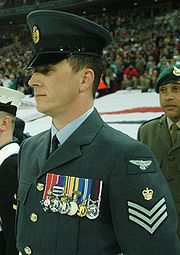
Military uniform
Military uniforms comprises standardised dress worn by members of the armed forces and paramilitaries of various nations. Military dress and military styles have gone through great changes over the centuries from colourful and elaborate to extremely utilitarian...
worn by members of the Royal Air Force
Royal Air Force
The Royal Air Force is the aerial warfare service branch of the British Armed Forces. Formed on 1 April 1918, it is the oldest independent air force in the world...
. The predominant colours of Royal Air Force uniforms are blue-grey and Wedgewood blue. Many Commonwealth air forces' uniforms are also based on the RAF pattern, but with nationality shoulder flashes. Cadets of the British ATC and CCF (RAF) Sections wear similar uniforms.
Official numbering
The RAF currently numbers the various uniforms which may be worn. The following table summarizes the numbering:| Number | Name | Notes on use |
|---|---|---|
| No 1 | Service Dress | In temperate regions. |
| No 2 | Service Working Dress | In temperate regions. |
| No 3 | Operational Clothing | Different patterns for different climates. |
| No 4 | Interim Mess Dress | For personnel without No 5 dress. |
| No 5 | Mess Dress | In temperate regions. |
| No 6 | Service Dress | In warm weather regions. In stone colour, except for 6A (full ceremonial) which is white. |
| No 7 | Service Working Dress | In warm weather regions. In stone colour. |
| No 8 | Mess Dress | In warm weather regions. Jacket in white. |
| No 9 | RAF Music Services RAF Music Services Royal Air Force Music Services is based at RAF Northolt and RAF Cranwell, and forms the central administration of one hundred and seventy musicians divided between the Central Band of the Royal Air Force, The Band of the Royal Air Force College, The Band of the Royal Air Force Regiment and... uniform |
For Directors of Music, bandmasters and musicians |
| No 10 | RAF Music Services uniform | For Directors of Music, bandmasters and musicians |
| No 11 | RAF Music Services uniform | For Directors of Music, bandmasters and musicians |
| No 12 | Physical Training Instructor Physical Training Instructor Physical Training Instructor is a term used primarily in the British Armed Forces and British police, as well as some other Commonwealth countries, for an instructor in physical fitness.-United Kingdom:... Dress |
Various patterns |
| No 13 | Physical Training Instructor Dress - Parachute Jump Instructor Duties | With helmet or beret |
| No 14 | Flying Clothing | Various patterns. Consists of a flight suit and optional jacket |
Service dress
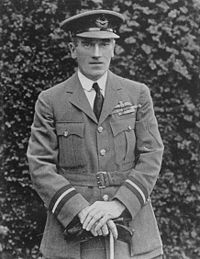
Service dress
Service Dress may refer to any of several military uniforms:*Service Dress *Service Dress, a uniform of the United States Navy*Service Dress, a uniform of the United States Air Force...
is worn on formal and ceremonial occasions. In temperate regions, it is the most formal uniform in use at present. It remains essentially unchanged from the service dress uniform adopted in the early 1920s. It consists of a blue-grey jacket and trousers (or skirt for female personnel). A great coat may be worn at ceremonial events when the weather is cold.
In 1947, the temperate officers' services dress jacket was altered. The lower side pockets were removed and the single slit was replaced by two hacking jacket style slits. The lower button was moved up to a position behind the belt and silk embroidery flying badges
Aircrew brevet
An aircrew brevet is the badge worn on the left breast, above any medal ribbons, by qualified aircrew in the Royal Air Force, British Army, Indian Air Force, Canadian Forces, Australian Army, Royal Australian Air Force, Royal New Zealand Air Force, South African Air Force and Sri Lanka Air...
were replaced with ones in bullion embroidery. These changes were unpopular and in 1951, with the exception of the lower button move, the former uniform style was re-adopted.
Service dress takes the following forms:
- No. 1 Service Dress, for temperate regions. Blue-grey colour.
- No. 1A Service Dress (Ceremonial Day Dress), for temperate regions and for air officerAir OfficerAn air officer is a Royal Air Force officer of the rank of air commodore or higher. Such officers may be termed "officers of air rank". The term is also used by many Commonwealth nations who have a similar rank structure to the RAF....
s only. As per No. 1 Service Dress. Air vice-marshalAir Vice-MarshalAir vice-marshal is a two-star air-officer rank which originated in and continues to be used by the Royal Air Force. The rank is also used by the air forces of many countries which have historical British influence and it is sometimes used as the English translation of an equivalent rank in...
s and above wear a ceremonial sash and shoulder boards. Entitled air commodoreAir CommodoreAir commodore is an air-officer rank which originated in and continues to be used by the Royal Air Force...
s only add the ceremonial sash. - No. 6 Service Dress, for tropical regions. Stone colour.
Service working dress
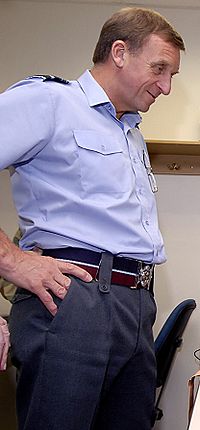
- No 2: Long sleeve shirt with jumper, tie optional
- No 2a: Long sleeve shirt with tie, jumper not worn
- No 2b: Short sleeve shirt without tie, jumper optional
- No 2c: Long sleeve dark blue shirt without tie, jumper optional (certain trades only)
The RAF stable belt
Stable belt
A stable belt is an item of uniform used in the armed forces of the United Kingdom and other Commonwealth countries. Stable belts or similar derivatives are also worn by the armed forced of other nations such as Denmark....
may be worn with all forms of service working dress.
Flying duties
Aircrew-specific uniforms are officially designated as Number 14 Dress by the RAF. Aircrew on flying duties wear an olive drab flying suit in temperate regions or a khaki flying suit in desert regions. A leather flying jacket, purchased at individual expense, may be worn with the flying suit but only while the wearer is on the ground.Ground duties
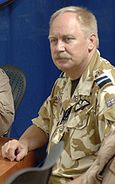
Disruptive Pattern Material
Disruptive Pattern Material is the commonly used name of a camouflage pattern used by British forces as well many other armies worldwide, particularly in former British colonies....
uniform which is essentially the same as the British Army
British Army
The British Army is the land warfare branch of Her Majesty's Armed Forces in the United Kingdom. It came into being with the unification of the Kingdom of England and Scotland into the Kingdom of Great Britain in 1707. The new British Army incorporated Regiments that had already existed in England...
's operational uniform. In temperate regions Combat Soldier 95 uniform is worn and in desert regions, Desert Combat Clothing is worn.
In order to distinguish RAF personnel from other UK armed forces, in 2006 an operational clothing identity patch was introduced with the text "ROYAL AIR FORCE" in black capitals on a green background. The patch is worn over the right chest pocket, the Desert Combat DPM dress also features this "ROYAL AIR FORCE" text but it is not mandatory to have this patch whilst operationally deployed.
Also in 2006 a 45mm squared tactical recognition flash
Tactical recognition flash
100px|thumb|Red and blue tactical recognition flash of the [[Royal Artillery]].A Tactical Recognition Flash is a coloured patch worn on the arm of combat clothing by members of the Royal Navy, British Army and Royal Air Force to distinguish their Regiment or Corps in the absence of a cap badge. It...
was introduced for all personnel to wear on their operation clothing.
Mess dress
In the RAF mess dressMess dress
Mess dress is the military term for the formal evening dress worn in the mess or at other formal occasions. It is also known as mess uniform and mess kit...
, officially designated Number 5 dress, is worn at formal evening functions. All regular officers possess mess dress whereas warrant officers and senior non-commissioned officers wear mess dress if they choose to purchase it. The current mess dress for men consists of a high waisted blue-grey single-breasted jacket fastened at the front by a single link of two RAF buttons connected by a link clip, white marcella shirt, bow tie, waistcoat or cummerbund and blue-grey trousers. Rank, for officers, is indicated in gold braid on the lower sleeve.
The first RAF mess dress was introduced in 1920 and it featured a high waisted single-breasted blue-grey jacket which tapered to a point at the front below the waist. A blue-grey waistcoat, trousers and black shoes were also worn. Rank was indicated on shoulder boards in gold lace. This uniform was modified in 1928 when the shoes were replaced by boots and overalls with gold lace and bright blue stripes were introduced. This modified form of the uniform lasted until 1934 when it was replaced by a version similar to the current men's mess dress. The wearing of mess dress was suspended during World War II
World War II
World War II, or the Second World War , was a global conflict lasting from 1939 to 1945, involving most of the world's nations—including all of the great powers—eventually forming two opposing military alliances: the Allies and the Axis...
.
For women, mess dress currently consists of the same style high waisted blue-grey single-breasted jacket and white marcella shirt as men, a small bow tie and cummerbund and a straight ankle length blue-gray skirt, worn with patent-leather court shoes and barely-black tights or stockings. From the 1970s and prior to the introduction of current women's mess dress in 1996, female officers wore a royal blue "Empire line" dress made of crimplene
Crimplene
Crimplene is a thick yarn used to make a fabric of the same name. The resulting cloth is heavy, wrinkle-resistant and retains its shape well. Britain's defunct ICI Fibres laboratory developed the fibre in the early 1950s and it is commonly thought it was named after the Crimple Valley in which the...
material with a loose mandarin neck, long sleeves and an ankle length hem. Rank was indicated on a small enamelled brooch worn near the neck.
Officers
Officer (armed forces)
An officer is a member of an armed force or uniformed service who holds a position of authority. Commissioned officers derive authority directly from a sovereign power and, as such, hold a commission charging them with the duties and responsibilities of a specific office or position...
serving at Scottish stations
RAF station
A Royal Air Force station is a permanent Royal Air Force operations location. Many RAF stations are aerodromes, or airbases, being the home to one or more flying squadrons. Other RAF stations are training units, administrative units, headquarters , or carry out ground-based operational tasks...
may wear the RAF tartan
Tartan
Tartan is a pattern consisting of criss-crossed horizontal and vertical bands in multiple colours. Tartans originated in woven wool, but now they are made in many other materials. Tartan is particularly associated with Scotland. Scottish kilts almost always have tartan patterns...
with their mess dress. The tartan was designed in 1988 and it was officially recognised by the Ministry of Defence
Ministry of Defence (United Kingdom)
The Ministry of Defence is the United Kingdom government department responsible for implementation of government defence policy and is the headquarters of the British Armed Forces....
in 2001. The tartan is also worn by the RAF's voluntary pipes bands, although not as part of an official RAF uniform.
RAF personnel without No 5 dress, such as airmen, junior officer cadets and some non-regular officers, wear No 1 dress with the blue shirt and tie replaced with a white marcella
Pique
Piqué, or marcella, refers to a weaving style, normally used with cotton yarn, which is characterized by raised parallel cords or fine ribbing. Twilled cotton and corded cotton are close relatives....
shirt and black bow tie should the need to wear mess dress arise. This dress pattern is officially designated Number 4 Dress and was previously known as (Interim) Mess Dress.
Full dress
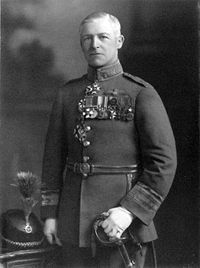
Full dress
Full dress is a category dress codes that refers to most formal clothing available in Western society.-Civilian:For a civilian, during the Victorian and Edwardian period, this corresponded to a frock coat in the day, and white tie at night...
uniform. It consisted of a single-breasted jacket in blue-grey with a stand-up collar. Rank was indicated in gold braid on the lower sleeve and white gloves were worn.
Initially the full dress uniform was worn with the service dress cap. However, in 1921 a new form of head-dress was introduced. It was designed to resemble the original flying helmet and it consisted of a leather skull cap trimmed with black rabbit fur. The helmet also featured an ostrich feather plume which was connected at an RAF badge. This helmet was never popular and junior officers were eventually permitted to wear the service dress hat on full dress occasions.
Group Captain
Group Captain
Group captain is a senior commissioned rank in the Royal Air Force and the air forces of many other Commonwealth countries. It ranks above wing commander and immediately below air commodore...
HRH the Duke of York (later King George VI
George VI of the United Kingdom
George VI was King of the United Kingdom and the Dominions of the British Commonwealth from 11 December 1936 until his death...
) wore RAF full dress at his wedding
Wedding of Prince Albert, Duke of York, and Lady Elizabeth Bowes-Lyon
The wedding of Prince Albert, Duke of York , and Lady Elizabeth Bowes-Lyon took place on 26 April 1923 at Westminster Abbey.-Courtship and proposals:...
to Lady Elizabeth Bowes-Lyon
Elizabeth Bowes-Lyon
Elizabeth Angela Marguerite Bowes-Lyon was the queen consort of King George VI from 1936 until her husband's death in 1952, after which she was known as Queen Elizabeth The Queen Mother, to avoid confusion with her daughter, Queen Elizabeth II...
in 1923. The Duke wore or carried the full dress headgear rather than the service dress cap.
Today the blue-grey full dress uniform is no longer worn, except in a modified form by RAF bandsmen.
There is also a full dress uniform for use by officers in the tropics, officially designated as No.6A Full Ceremonial Dress (Warm Weather Areas). It consists of a white tunic with stand collar, matching trousers, blue-grey peaked cap and black leather shoes. It is only issued to specific appointment holders (e.g. aide-de-camp
Aide-de-camp
An aide-de-camp is a personal assistant, secretary, or adjutant to a person of high rank, usually a senior military officer or a head of state...
and air attaché
Air attaché
An air attaché is an Air Force officer who is part of a diplomatic mission; this post is normally filled by a high-ranking officer.An air attaché typically represents the chief of his home air force in the foreign country where he serves. The day-to-day responsibilities include maintaining contacts...
), and even then these are hardly ever worn. Other officers may purchase the uniform at their own expense but few choose to do so.
Initial uniform
With the establishment of the Royal Air Force as an independent service on 1 April 1918, orders were issued detailing new uniform patterns. Major General Mark Kerr designed the first officer uniform which was largely pale blue with gold braid trimmings. Additionally, the Royal Flying CorpsRoyal Flying Corps
The Royal Flying Corps was the over-land air arm of the British military during most of the First World War. During the early part of the war, the RFC's responsibilities were centred on support of the British Army, via artillery co-operation and photographic reconnaissance...
' use of khaki
Khaki
This article is about the fabric. For the color, see Khaki . Kaki, another name for the persimmon, is often misspelled "Khaki".Khaki is a type of fabric or the color of such fabric...
was continued. It has been suggested that the pale blue colour was adopted as the cloth had been intended for use by the Imperial Russian Cavalry and, following their disbandment after the Bolshevik Revolution
October Revolution
The October Revolution , also known as the Great October Socialist Revolution , Red October, the October Uprising or the Bolshevik Revolution, was a political revolution and a part of the Russian Revolution of 1917...
it became available at low cost. As it was the responsibility of officers to buy their own uniforms, a wearing-out period for old uniforms was allowed and the change-over to the air force uniform was slow.
The 'wearing out' period also applied to other ranks
Other Ranks
Other Ranks in the British Army, Royal Marines and Royal Air Force are those personnel who are not commissioned officers. In the Royal Navy, these personnel are called ratings...
. Former members of the Royal Flying Corps and the Royal Naval Air Service continued to wear their old uniforms. New recruits into the newly formed Royal Air Force were often issued with the khaki Army Pattern General Service Tunic.
Later in 1918 a belted khaki uniform was adopted for other ranks, and it was these tunics that first carried the RAF eagle badges on each shoulder.
The pale blue colour for officers' uniforms was unpopular and impractical and John Slessor
John Slessor
Marshal of the Royal Air Force Sir John Cotesworth Slessor GCB, DSO, MC was a senior commander in the Royal Air Force . A pilot in the Royal Flying Corps during World War I, he held operational commands in World War II and served in the RAF's most senior post, Chief of the Air Staff, from 1950 to...
who was later promoted to Marshal of the RAF described it as "a nasty pale blue with a lot of gold over it, which brought irresistibly to mind a vision of the gentlemen who stands outside the cinema". A little over a year after its introduction, the pale blue colour was discontinued. On the 15 September 1919, Air Ministry
Air Ministry
The Air Ministry was a department of the British Government with the responsibility of managing the affairs of the Royal Air Force, that existed from 1918 to 1964...
Order 1049 replaced it with the blue-grey colour which has remained in use to this day. The khaki uniform continued to be worn until 1924 when it too was replaced by a blue-grey colour.
War service dress
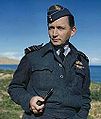
Battle Dress
Battle Dress was the specific title of a military uniform adopted by the British Army in the late 1930s and worn until the 1960s. Several other nations also introduced variants of Battle Dress during the Second World War, including Australia, Canada, India, New Zealand, South Africa, and the...
. Initially, war service dress was only worn by air crew. However, in 1943, its use was authorised for all ranks and trades. War service dress continued to be worn after the end of World War II
World War II
World War II, or the Second World War , was a global conflict lasting from 1939 to 1945, involving most of the world's nations—including all of the great powers—eventually forming two opposing military alliances: the Allies and the Axis...
. It was significantly altered in 1948 and not phased out until 1973.
1972 pattern service working dress
During 1973 the wartime "Hairy Mary" working dress uniforms were replaced for all ranks with the 1972 pattern No 2 uniforms. Made of a smooth woollen and man-made fibre mix material the jacket was a loose blouson design with a front zip fastener and epaulettes. Earlier RAF blue crew-necked woollen pullovers were replaced with a new V-neck design featuring blue-grey cloth elbow and shoulder patches plus a pen holder patch on the left sleeve.Introduced at the same time was an RAF blue nylon foul weather jacket and overtrousers. Although not initially intended it quickly became standard practice for officers and other ranks to attach rank badges to the lapels and wear the nylon jacket in place of the uniform raincoat, as a more practical modern wear.
Influence on other air forces
The Royal New Zealand Air ForceRoyal New Zealand Air Force
The Royal New Zealand Air Force is the air arm of the New Zealand Defence Force...
uniform is also of the RAF pattern, but with nationality shoulder flashes. The Indian Air Force
Indian Air Force
The Indian Air Force is the air arm of the Indian armed forces. Its primary responsibility is to secure Indian airspace and to conduct aerial warfare during a conflict...
uniform is also of a similar pattern to the RAF uniform. The Royal Australian Air Force
Royal Australian Air Force
The Royal Australian Air Force is the air force branch of the Australian Defence Force. The RAAF was formed in March 1921. It continues the traditions of the Australian Flying Corps , which was formed on 22 October 1912. The RAAF has taken part in many of the 20th century's major conflicts...
uniform is in midnight blue, instead of grey-blue. Prior to the 1968 unification of the Canadian Forces
Canadian Forces
The Canadian Forces , officially the Canadian Armed Forces , are the unified armed forces of Canada, as constituted by the National Defence Act, which states: "The Canadian Forces are the armed forces of Her Majesty raised by Canada and consist of one Service called the Canadian Armed Forces."...
, the Royal Canadian Air Force
Royal Canadian Air Force
The history of the Royal Canadian Air Force begins in 1920, when the air force was created as the Canadian Air Force . In 1924 the CAF was renamed the Royal Canadian Air Force and granted royal sanction by King George V. The RCAF existed as an independent service until 1968...
service dress was nearly identical to that of the RAF, and the Distinctive Environmental Uniform (DEU) of the modern Canadian Forces air command now known as the Royal Canadian Air Force
Royal Canadian Air Force
The history of the Royal Canadian Air Force begins in 1920, when the air force was created as the Canadian Air Force . In 1924 the CAF was renamed the Royal Canadian Air Force and granted royal sanction by King George V. The RCAF existed as an independent service until 1968...
maintains that similarity, though with distinctive RCAF ranks and insignia. Cadets of the ATC
Air Training Corps
The Air Training Corps , commonly known as the Air Cadets, is a cadet organisation based in the United Kingdom. It is a voluntary youth group which is part of the Air Cadet Organisation and the Royal Air Force . It is supported by the Ministry of Defence, with a regular RAF Officer, currently Air...
and CCF
Combined Cadet Force
The Combined Cadet Force is a Ministry of Defence sponsored youth organisation in the United Kingdom. Its aim is to "provide a disciplined organisation in a school so that pupils may develop powers of leadership by means of training to promote the qualities of responsibility, self reliance,...
(RAF) Sections wear similar uniforms
Uniform of the Air Cadet Organisation
All cadets and uniformed staff members of the Air Cadet Organisation wear a uniform based on the one worn by regular members of the Royal Air Force...
.

